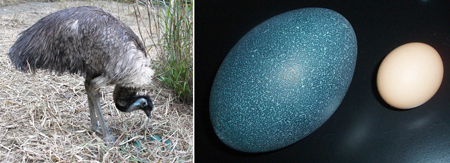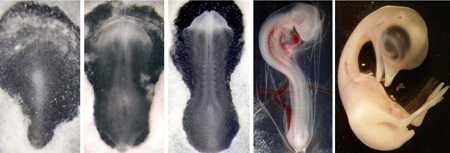| RIKEN Center for Developmental Biology (CDB) 2-2-3 Minatojima minamimachi, Chuo-ku, Kobe 650-0047, Japan |
January 20, 2011 – Birds are useful models in developmental biology, given their large, external eggs and an array of classic embryology techniques, but the study of avian development has been dominated by a single species, the chicken Gallus gallus. While a few other bird varieties have been studied for purposes of comparison, these have all been from the “modern” species (neognaths), such as quail, duck and pheasant. A number of more basal bird species (palaeognaths), including ostrich, rhea, kiwi, and emu survive, but their development has remained unstudied.
Now, in a report published in Developmental Dynamics, Hiroki Nagai of the Laboratory of Early Embryogenesis (Guojun Sheng, Team Leader) and colleagues from the same lab as well as the Laboratory for Sensory Development (Raj Ladher, Team Leader) provide a comparative description of the development of the emu, Dromaius novaehollandiae, with that of the better-known chick. The team found that while the two birds’ proceed through similar embryonic stages, a number of differences in timing and pace set them on the widely diverging courses manifested in their adult forms. Nagai’s approach centered on identifying emu equivalents for Hamilton-Hamburger stages in the chick. The Hamburger-Hamilton (HH) system uses definitive morphological characteristics to determine the state of development, and is the gold standard in staging chick embryos. As a general rule, emus take 2–3 times longer than chicks to reach the same HH stage. The early development of the emu resembles that of the chick until HH7. During subsequent stages in which somites form, however, the emu forms a greater number of these structures than the chick. The emu somitogenic period was calculated to be 100–110 min, slightly longer than the 90 minutes in chick embryos. The forelimbs in adult emus are diminutive, which is reflected in development as well. The forelimb buds form and undergo initial patterning, but these appendages fail to grow apace with the rest of the embryo body, including the hindlimbs. Interestingly, adult emus also have fewer forelimb digits than do other birds, a difference that is also observable at the stage of the limb’s patterning. Once the limb buds have formed, the emu embryo begins a growth spurt that results in the enormous size differential with the chick. In addition to their comprehensive morphological observations, the team looked at the expression of a number of genes, such as Sonic hedgehog (Shh), Brachyury, and Chordin, known to be important in early development. Expression patterns were similar to those in chick up to stage 7, when the first somite appears, with the single exception that the Brachyury expression begins slightly later in emu.
“Since a brief description by Haswell in 1887, there has not been any published study of emu development,” says Sheng. “In staging these embryos, we learned of the high level of conservation of developmental routines across bird orders, which suggests that findings from the chick may well apply generally to birds. That said, we also saw heterochrony in the development of specific tissues and structures between chick and emu, so we look forward to studying these embryos in more detail through cell labeling, transplants, and imaging techniques.” |
|||||||
|
|||||||
 |
| Copyright (C) CENTER FOR DEVELOPMENTAL BIOLOGY All rights reserved. |

